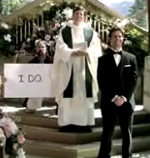The King Wakes Your Sleepy Ass
Posted in: Uncategorized
It’s not like Burger King commercials could get any weirder.

It’s not like Burger King commercials could get any weirder.

When Shirley Temple was around four years old, she participated in this series of shorts called “Baby Burlesques.” In one, she poses as a bar maid while scrappy boys dressed like seedy men court her with progressively larger lollipops.

Heineken follows up its ultra-popular walk-in fridge spot with “Walking Fridge.”

Ozzy Osbourne appears in his third (or fourth?) Samsung spot, this time for the Alias 2.

It’s with relief that we can say successful online video campaigns have evolved from the astroturf amateur days.

Air New Zealand promotes its no-hidden-fees policy with an ad where pilots, flight attendants and baggage jockeys sport nothing but paint in lieu of uniforms.

Diggin’ this surreal and totally retro spot for Matthew Williamson’s H&M line, which Jeremy Dante was kind enough to throw into our periphery.

– Magnetic poetry a la Twitter.

In “Wedding,” Goodby Silverstein & Partners explore what it’d be like if film crews ran the world.
The One Show is debuting a Green Pencil award to honour “the one piece or campaign that best represents the highest standards of excellence in the field of environmental advertising” (…aaaaaand rake in more preliminary entry dosh).

– Current.tv’s TwitteRFP goes to…
 Like the Robinson’s robot from Lost In Space, someone has obviously been warning “The Suits” at MySpace “Danger! Danger! You are losing users!” To MySpace’s credit, they listened, and have introduced new user features (Profile 2.0), revised their music section, and launched a “connect” feature. They also announced that they had ousted their CEO to bring in a former Facebook exec, Owen Van Natta. (No one is quite sure what happened to ever-friendly Tom…) Additionally, MySpace is offering a beta version of MySpace Local which provides some of the functionality of Twitter, like; “Where can I get a great Tuna Sandwich in Kansas City?”
Like the Robinson’s robot from Lost In Space, someone has obviously been warning “The Suits” at MySpace “Danger! Danger! You are losing users!” To MySpace’s credit, they listened, and have introduced new user features (Profile 2.0), revised their music section, and launched a “connect” feature. They also announced that they had ousted their CEO to bring in a former Facebook exec, Owen Van Natta. (No one is quite sure what happened to ever-friendly Tom…) Additionally, MySpace is offering a beta version of MySpace Local which provides some of the functionality of Twitter, like; “Where can I get a great Tuna Sandwich in Kansas City?”
To be honest, other than the music search on MySpace, it’s been dead to me. And the music portion, until lately, wasn’t the simplest to use: if you sift through enough crap, you could find a among the shattered glass: One listen to A Fine Frenzy and you’ll know what I mean. However, the newly revamped music features on MySpace are far better than what they had, and leagues beyond anything Facebook has to offer. 
Yet is it too little, too late? Should MySpace have made these changes mid-year 2008 when they knew Facebook was coming on hard? Facebook overtook MySpace as the largest Social Network in existence, and it’s not showing any sign of slowing down. (My mother, in her 60s, recently added a Facebook account to keep up with the “kids;” we are all over thirty.) So, Facebook’s growth, in addition to the growth rate of Twitter (1300 percent from 2008 to 2009) leaves MySpace with difficult challenges to overcome. (See the graph, below, courtesy of Compete.)
It’s doubtful in the near term, but it will depend on Van Natta’s leadership, innovation, and speed. MySpace will also need to rollout MySpace II carefully, not offending current users but also regaining previous members. The other huge benefit for MySpace: it’s owned by NewsCorp, the same company that owns Fox News, The Wall Street Journal, and The New York Post. With that kind of breaking-news potential backing the site, it’s possible that MySpace may emerge as a combination between Digg and Facebook, with an awesome music application, online dating services, and the Twitter-like MySpace Local application.
Another hurdle for MySpace is to overcome its “ghetto” feel when compared to Facebook. Facebook is branded thoroughly on every page of the site whereas MySpace has multiple skins that can  be utilized; some from third party vendors that cause the pages not to load correctly or even hang your browser. Additionally, MySpace is not positioned like Facebook in regard to the “employment” factor. Facebook is setup to “brand” yourself to potential employers…which means that tend to keep it clean of profanity in the headings, as well as use actual names rather than online IDs. But, then again, maybe that is part of its charm. Facebook has experienced their share of problems; they’ve disenchanted some of their members with sweeping changes to their privacy policies (although later rescinded), and have changed the user interface, much to the chagrin of many. In fact, many demand that the “old” Facebook be brought back. Finally, Facebook CEO, Mark Zuckerberg, seems to be a wild card that holds the future of the site in his hands, as evidenced by the mysterious departure of Chief Financial Officer, Gideon Yu. Yu’s departure was the latest change of several in the upper ranks at Facebook, “whose employees and investors are anxious about Chief Executive Mark Zuckerberg’s plans for the social-networking site.”
be utilized; some from third party vendors that cause the pages not to load correctly or even hang your browser. Additionally, MySpace is not positioned like Facebook in regard to the “employment” factor. Facebook is setup to “brand” yourself to potential employers…which means that tend to keep it clean of profanity in the headings, as well as use actual names rather than online IDs. But, then again, maybe that is part of its charm. Facebook has experienced their share of problems; they’ve disenchanted some of their members with sweeping changes to their privacy policies (although later rescinded), and have changed the user interface, much to the chagrin of many. In fact, many demand that the “old” Facebook be brought back. Finally, Facebook CEO, Mark Zuckerberg, seems to be a wild card that holds the future of the site in his hands, as evidenced by the mysterious departure of Chief Financial Officer, Gideon Yu. Yu’s departure was the latest change of several in the upper ranks at Facebook, “whose employees and investors are anxious about Chief Executive Mark Zuckerberg’s plans for the social-networking site.”
MySpace’s biggest challenge is to implement their changes quickly; not only to maintain their 130 million current members, but to also reel in former users that broke rank. MySpace and Flixter were the only two Social Networking platforms to lose users from 2008 to 2009.
Jeff Louis is a Strategic Media Planner, Project Manager, and New Business Coordinator. His passion is writing, contributing to BMA as well as freelancing. He’d love to hear from you: linkedin.com/in/jefflouis or twitter.com/jlo0312.

There’s a hot new energy drink on the block. It’s called Guru, and it boasts clean energy for dirty minds.

AT&T makes a deposit into karmic collections in this collaboration with TOMS Shoes, a cause-based shoe firm that gives one pair of shoes away to a needy kid every time you — yes, you! — buy a pair.
Have you seen that AdAge Series, PLAN B? It is an ongoing dialog about the state of our industry, and it’s as enlightening as it is scary. If you have not read it, do so when you have a chance. After I did, I started looking for someone, anyone to blame. All those bad decisions…who could I blame? Then, for some odd reason, I decided to look inside for a culprit. Where did I go wrong in this mess? It is something I suggest we all do. We can blame our industry’s situation on the economy, big business, or the government, but the truth is that it’s our fault. We are the innovators and the creators. We build brands and lead the way. We determine the direction. We  construct the future.
construct the future.
At some point, we became followers. We became corporations. We accepted status quo. We bought our competitors and became complacent.
We became Remoras…content suckerfish attached to Big Fish for protection, transportation, and food. Although supposedly a symbiotic relationship, the truth of the matter is that we need them to survive, and they don’t need us at all. So, as we free wheeled through the ocean, traveling vast distances but never really getting anywhere, we were scraped off and left behind. With no transportation, protection, or food, what are we supposed to do now? “Hey, let’s look for another Big Fish to provide for us.” Well, guess what? The big fish had their own problems and moved to the other side of the ocean, leaving us no way to get there.
Am I wrong? Perhaps a bit foolish? Probably. On the other hand, maybe I just see it differently. As the innovators, creators, builders, and leaders, it falls on us to do the right thing for our clients’ best interest, all the time. Even if it means openly disagreeing. I’ve sat through meetings, sans client, with their marketing plans spread out in front of us, knowing straight out that they would not work, or that were riddled with holes. Did we call our clients and say; “You know, this plan looks great, but, our research tells us that it probably won’t work. And here is why…” Nope. We presented them with options to choose from, but never told them what we actually recommended. We were never bluntly honest.
Clients pay us for service, expertise, and insight. As an agency, it is our job to be the watchdogs, the experts, and protectors. We know our brands intimately; we helped build them. Therefore, we should have the foresight to know what’s coming. Which of us looked at the state of the auto industry and told our clients the truth? How many of us reminded our banking clients that offering high-risk loans was a long-term mistake? Which of us stood up for what we KNEW was right, even if it meant risking the relationship?
We let them down, and now we are paying for our sins. Unlike the other industries, don’t expect a bail out…we don’t produce anything tangible.
Do you want to be of value to your clients? Be Honest. Be Unmerciful. Otherwise, we will continue to strangle this business that we love.
Jeff Louis: Strategic Media Planner & Buyer with over seven years of experience. Interests include emerging media, radical ideas, & redefining the status quo. He’s passionate about writing and digs great creative.
Reach him on twitter @jlo0312 or www.LinkedIn.com/in/jefflouis.